太极拳英文基本术语
- 格式:doc
- 大小:29.01 KB
- 文档页数:13
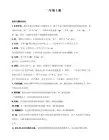
Wu Shu Terminology - Wu Shu Shuyu 武术术语Chinese and Foreigners can learn these terms - 中国人和外国人可以学习这些术语Chinese can learn English Terms used in AmericaForeigners can learn the Pinyin Terms and PronounciationSalutation - Zhi Jing 致敬Attention - Zhu Yi (ju yee) 注意 or Stand at Attention - Li Zheng (lee jeng) 立正Bow to Shi Fu - Xiang Shifu Ju Gong (sheeang shi foo ju gong) 向师傅鞠躬Numbers - Shu Zi 数字1. yi (yee) 一2. er (R) 二3. san (san) 三4. si 四5. wu 五6. liu (leo) 六7. qi (chee) 七8. ba 八9. jiu (geo) 九10. shi 十11. shi yi 十一12. shi er 十二13. shi san十三14. shi si 十四15. shi wu 十五16. shi liu 十六17. shi qi 十七18. shi ba 十八19. shi jiu 十九20. er shi 二十Levels - Deng Ji - 等级Beginner - Chu Ji - 初级Intermediate - Zhong Ji - 中级Advanced - Gao Ji - 高级Professional - Zhuan Ye Ji- 专业级Stances - Bu Xing 步型Horse Stance- Ma Bu 马步Bow Stance- Gong Bu 弓步Drop Stance- Pu Bu 仆步Resting Stance- Xie Bu (sheeye bu) 歇步Empty Stance- Xu Bu (shu bu) 虚步Cross Leg Bow Stance- Cha Bu 插步Drop Leg Bow Stance - Gui Bu 跪步Fox Run – Xing Bu 行步Sashe Skip – Ta Bu 踏步Skip Jump Palms over Head Leap – Yue Bu 跃步Fist - Shou Xing 手型Fist- Quan (chwen) 拳Palm- Zhang 掌Hook- Gou (go) 勾Slap fist- Za Quan (za chwen) 砸拳Wheeling Arms- Wu Long Pan Da 乌龙盘打Elbow Thrusts – Ding Zhou 顶肘Horizontal Chops – Kan Zhang 砍掌Low Upper Cut Palm – Liao Zhang 撩掌Overhead Block & Spearhand Thrust – Chuan Zhang 穿掌Overhead Palm – Liang Zhang 亮掌Palm Pushing – Tui Zhang 推掌Hammer Strike – Pi Quan 皮拳Thrust Punch - Chong Quan 冲拳Stretch Kicks - Rou Ren 柔韧Left Leg Front Split - Shu Cha 竖叉Side Split – Heng Cha 横叉Front Kick - Zheng Ti Tui (jun tee tway) 正踢腿Outside Crescent- Wai Bai Tui.(y bye tway) 外摆腿Outside Crescent w/ slap - Bai Lian Pai Jiao 外摆拍脚Inside Crescent- Li He Tui (lee huh tway) 里合腿Inside Crescent w/ slap – Li He Pai Jiao 里合拍脚Side Stretch Kick- Ce Ya Tui (tsuh ya tway) 侧压腿Side Kick- Ce Ti Tui (tsuh tee tway) 侧踢腿Front Slap Kick- Pai Jiao (pie jeeow) 拍脚Step & Kick back – Hou Liao Tui 后撩腿Front Thrust kick & punch – Tan Tui 弹腿Front Thrust Heel kick & punch – Deng Tui 蹬腿Front Sweep – Qian Sao Tui 前扫腿Back Sweep – Hou Siao Tui 后扫腿Balances - Peng Heng 平衡Rooster Balance – Ti Xi Ping Heng 提膝平衡Skyward Balance – Chao Tian Deng 朝天蹬Hooked Leg Empty Stance – Kong Tui Ping Heng 控腿平衡Twisted Leg Balance – Wang Yue Ping Heng 望月平衡Back Leg Balance – Yan Shi Ping Heng 燕式平衡Scale Forward Lean Back – Yang Shen Ping Heng 仰身平衡Jumping Kicks - Tiao Yue 跳跃Frog Leaps- Wa Tiao (wa teeyow) 蛙跳Jumping Front Kick- Teng Kong Fei Jiao 腾空飞脚Jumping Double Front Slap – Shuang Fei Jiao 双飞脚Tornado- Xuan Feng Jiao (shuen fung jeeyow) 旋风脚Lotus Kick- Wai Bai Lian (why bye leeyan) 外摆莲 or Bai Lian Tui 摆莲腿Butterfly Kick- Xuan Zi (shuen tzu) 旋子Butterfly Twist- Xuan Zi San Bai Liu - 360 旋子三百六Xuan Zi Wu Bai Si – 540 旋子五百四Xuan Zi Qi Bai Er - 720 旋子七百二Acrobatics - Die Pu Gun Fan 跌扑滚翻Aerials – Ce Kong Fan 侧空翻Shoulder Rolls – Qiang Bei 抢背Kip Ups – Li Yu Da Ting 鲤鱼打挺Flying Sidekick Drop – Pan Tui Die 盘腿跌Black Dragon Spin to handstand – Wu Long Jiao Zhu 乌龙绞柱Forms Quan Shu 拳术Long Fist – Chang Quan 长拳Southern Fist – Nan Quan 南拳Form & Will Boxing - Xing Yi Quan (shing yee chwen) 形意拳Eight Diagram Palm Boxing - Ba Gua Zhang (ba gwa zhang) 八卦掌Eagle Claw - Ying Zhao (ying jao) 鹰爪Drunken Fist - Zui Quan (zway chwen) 醉拳White Ape - Tong Bei Quan (tong bei chwen) 通背拳Mantis Boxing- Tang Lang Quan (tang lang chwen) 螳螂拳Earth Boxing- Di Tang Quan (dee tang chwen) 地躺拳Weapons - Qi Xie 器械Broadsword – Dao Shu 刀术Straightsword – Jian Shu 剑术Spear – Qiang Shu 枪术Staff- Gun Shu (gwen shu) 棍术Southern Staff – Nan Gun 南棍Southern Broadsword – Nan Dao 南刀Doublehooks – Shuang Gou 双钩3 Sectional Staff- San Jie Gun (san jeeye gwen) 三节棍Double Broadsword- Shuang Dao (shwang dow) 双刀Long Handle Broadsword- Pu Dao (pu dow) 朴刀Long Tassel Sword- Chang Sui Jian (chang suay jeeyen) 长穗剑Drunken Sword- Zui Jian (zway jeeyen) 醉剑9 Sectional Whip Chain- Jiu Jie Bian (geo jeeye beeyen) 九节鞭。
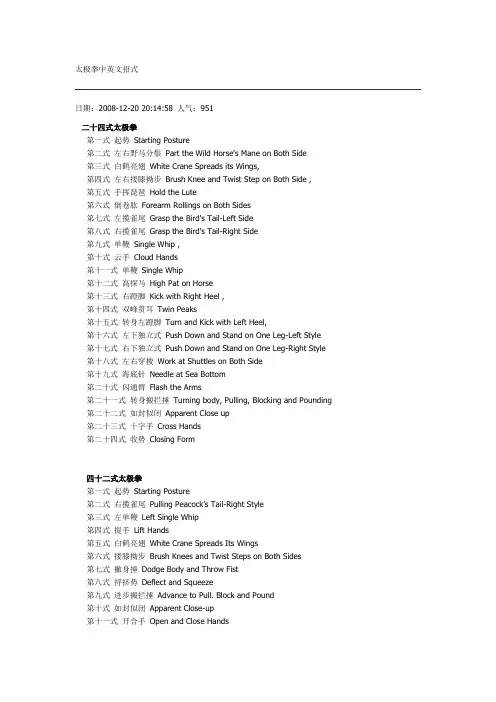
太极拳中英文招式日期:2008-12-20 20:14:58 人气:951二十四式太极拳第一式起势Starting Posture第二式左右野马分鬃Part the Wild Horse's Mane on Both Side第三式白鹤亮翅White Crane Spreads its Wings,第四式左右搂膝拗步Brush Knee and Twist Step on Both Side ,第五式手挥琵琶Hold the Lute第六式倒卷肱Forearm Rollings on Both Sides第七式左揽雀尾Grasp the Bird's Tail-Left Side第八式右揽雀尾Grasp the Bird's Tail-Right Side第九式单鞭Single Whip ,第十式云手Cloud Hands第十一式单鞭Single Whip第十二式高探马High Pat on Horse第十三式右蹬脚Kick with Right Heel ,第十四式双峰贯耳Twin Peaks第十五式转身左蹬脚Turn and Kick with Left Heel,第十六式左下独立式Push Down and Stand on One Leg-Left Style 第十七式右下独立式Push Down and Stand on One Leg-Right Style 第十八式左右穿梭Work at Shuttles on Both Side第十九式海底针Needle at Sea Bottom第二十式闪通臂Flash the Arms第二十一式转身搬拦捶Turning body, Pulling, Blocking and Pounding 第二十二式如封似闭Apparent Close up第二十三式十字手Cross Hands第二十四式收势Closing Form四十二式太极拳第一式起势Starting Posture第二式右揽雀尾Pulling Peacock’s Tail-Right Style第三式左单鞭Left Single Whip第四式提手Lift Hands第五式白鹤亮翅White Crane Spreads Its Wings第六式搂膝拗步Brush Knees and Twist Steps on Both Sides第七式撇身捶Dodge Body and Throw Fist第八式捋挤势Deflect and Squeeze第九式进步搬拦捶Advance to Pull. Block and Pound第十式如封似闭Apparent Close-up第十一式开合手Open and Close Hands第十二式右单鞭Right Single Whip第十三式肘底捶Punch under Elbow第十四式转身推掌Turn Body and Push Palm第十五式玉女穿梭Work at Shuttles on Both Sides第十六式右左蹬脚Heel Kicks on Both Sides第十七式掩手肱捶Hide Hands and Strike Fist第十八式野马分鬃Wild Horses Parting its Manes on Both Sides第十九式云手Cloud Hands第二十式独立打虎Beat Tiger on Single Leg第二十一式右分脚Toes Kick-Right第二十二式双峰贯耳Twin Peaks第二十三式左分脚Toes Kick-Left第二十四式转身拍脚Turn Body and Slap Foot第二十五式进步栽捶Advance and Punch Down第二十六式斜飞势Flying Obliquely第二十七式单鞭下势Single Whip and Push Down第二十八式金鸡独立Golden Rooster Stands on One Leg第二十九式退步穿掌Step Back and Pierce Palm第三十式虚步压掌Press Palm in Empty Stance第三十一式独立上托Stand on One Leg and Raise Palm第三十二式马步靠Push Forearm with Horse-Riding Step第三十三式转身大捋Turn Body and Deflect第三十四式歇步擒打Cross Legged Sitting Stance and Lock Stricke 第三十五式穿掌下势Pierce Palm and Push Down第三十六式上步七星Step Forward with Seven Stars第三十七式退步跨虎Back Step to Mount Tiger第三十八式转身摆莲Turn Body for Lotus Kick第三十九式弯弓射虎Draw Bow to Shoot Tiger第四十式左拦雀尾Pulling Peacock’s Tail-left第四十一式十字手Cross Hands第四十二式收势Closing Form。
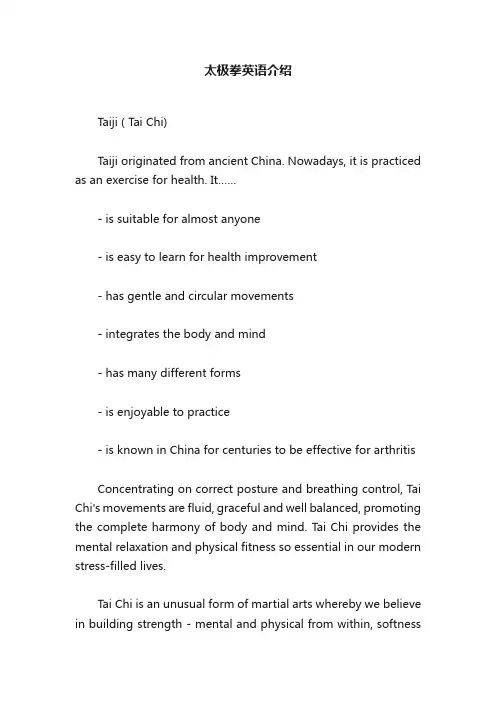
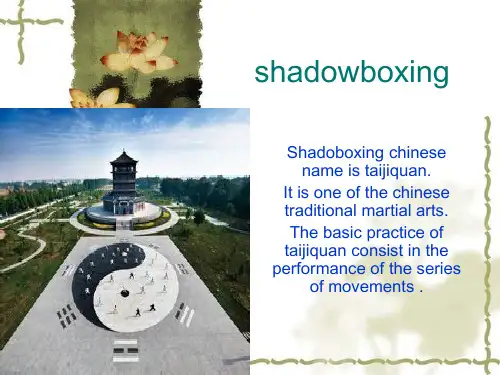
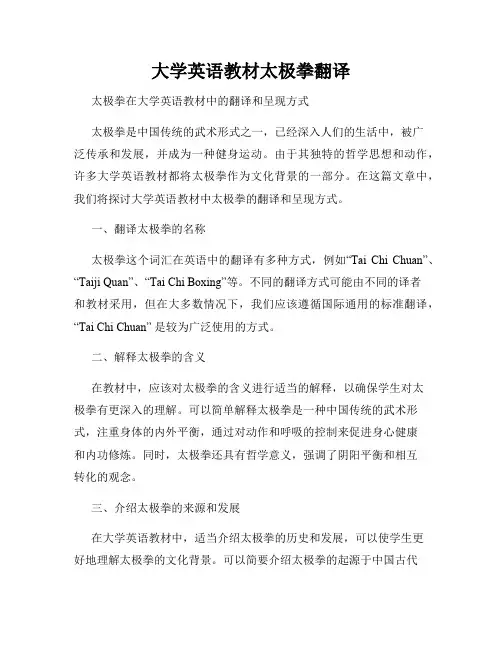
大学英语教材太极拳翻译太极拳在大学英语教材中的翻译和呈现方式太极拳是中国传统的武术形式之一,已经深入人们的生活中,被广泛传承和发展,并成为一种健身运动。
由于其独特的哲学思想和动作,许多大学英语教材都将太极拳作为文化背景的一部分。
在这篇文章中,我们将探讨大学英语教材中太极拳的翻译和呈现方式。
一、翻译太极拳的名称太极拳这个词汇在英语中的翻译有多种方式,例如“Tai Chi Chuan”、“Taiji Quan”、“Tai Chi Boxing”等。
不同的翻译方式可能由不同的译者和教材采用,但在大多数情况下,我们应该遵循国际通用的标准翻译,“Tai Chi Chuan” 是较为广泛使用的方式。
二、解释太极拳的含义在教材中,应该对太极拳的含义进行适当的解释,以确保学生对太极拳有更深入的理解。
可以简单解释太极拳是一种中国传统的武术形式,注重身体的内外平衡,通过对动作和呼吸的控制来促进身心健康和内功修炼。
同时,太极拳还具有哲学意义,强调了阴阳平衡和相互转化的观念。
三、介绍太极拳的来源和发展在大学英语教材中,适当介绍太极拳的历史和发展,可以使学生更好地理解太极拳的文化背景。
可以简要介绍太极拳的起源于中国古代的武术和哲学思想,如道家思想中的“无为而治”和儒家思想中的“和谐共处”等。
并且可以提及太极拳在中国的传承和发展,以及它如何成为一种广为流传和受欢迎的健身运动。
四、描述太极拳的动作和技术对于大多数学习英语的学生来说,他们可能对太极拳的具体动作和技术不太了解。
因此,在教材中可以通过文字描述、插图或视频等方式向学生展示太极拳的基本动作和技术。
在描述时,要使用简单明了的语言,并且尽量避免使用繁琐的专业术语,以便学生能够更容易理解和学习。
五、提供太极拳的实践和学习指导教材中不仅应该提供太极拳的背景知识,还应该给予学生一些实践和学习指导。
例如,可以提供一些基本的太极拳动作练习或者分享一些太极拳的学习资源,如书籍、网络视频等。
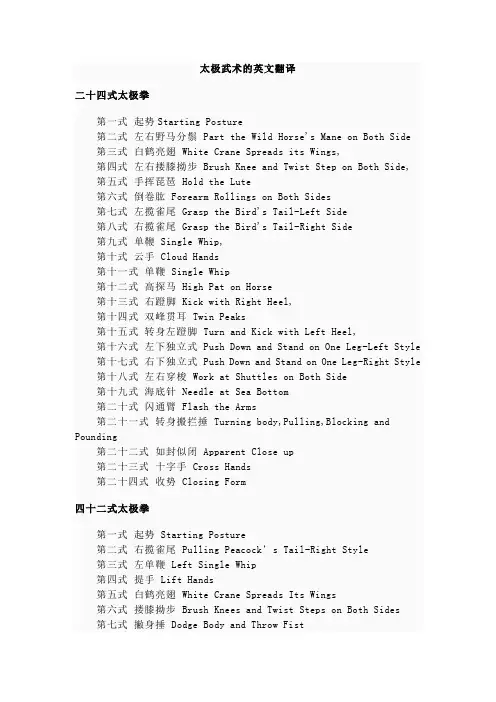
太极武术的英文翻译二十四式太极拳第一式起势Starting Posture第二式左右野马分鬃 Part the Wild Horse's Mane on Both Side 第三式白鹤亮翅 White Crane Spreads its Wings,第四式左右搂膝拗步 Brush Knee and Twist Step on Both Side, 第五式手挥琵琶 Hold the Lute第六式倒卷肱 Forearm Rollings on Both Sides第七式左揽雀尾 Grasp the Bird's Tail-Left Side第八式右揽雀尾 Grasp the Bird's Tail-Right Side第九式单鞭 Single Whip,第十式云手 Cloud Hands第十一式单鞭 Single Whip第十二式高探马 High Pat on Horse第十三式右蹬脚 Kick with Right Heel,第十四式双峰贯耳 Twin Peaks第十五式转身左蹬脚 Turn and Kick with Left Heel,第十六式左下独立式 Push Down and Stand on One Leg-Left Style 第十七式右下独立式 Push Down and Stand on One Leg-Right Style 第十八式左右穿梭 Work at Shuttles on Both Side第十九式海底针 Needle at Sea Bottom第二十式闪通臂 Flash the Arms第二十一式转身搬拦捶 Turning body,Pulling,Blocking and Pounding第二十二式如封似闭 Apparent Close up第二十三式十字手 Cross Hands第二十四式收势 Closing Form四十二式太极拳第一式起势 Starting Posture第二式右揽雀尾Pulling Peacock’s Tail-Right Style第三式左单鞭 Left Single Whip第四式提手 Lift Hands第五式白鹤亮翅 White Crane Spreads Its Wings第六式搂膝拗步 Brush Knees and Twist Steps on Both Sides第七式撇身捶 Dodge Body and Throw Fist第八式捋挤势 Deflect and Squeeze第九式进步搬拦捶 Advance to Pull. Block and Pound第十式如封似闭 Apparent Close-up第十一式开合手 Open and Close Hands第十二式右单鞭 Right Single Whip第十三式肘底捶 Punch under Elbow第十四式转身推掌 Turn Body and Push Palm第十五式玉女穿梭 Work at Shuttles on Both Sides第十六式右左蹬脚 Heel Kicks on Both Sides第十七式掩手肱捶 Hide Hands and Strike Fist第十八式野马分鬃 Wild Horses Parting its Manes on Both Sides 第十九式云手 Cloud Hands第二十式独立打虎 Beat Tiger on Single Leg第二十一式右分脚 Toes Kick-Right第二十二式双峰贯耳 Twin Peaks第二十三式左分脚 Toes Kick-Left第二十四式转身拍脚 Turn Body and Slap Foot第二十五式进步栽捶 Advance and Punch Down第二十六式斜飞势 Flying Obliquely第二十七式单鞭下势 Single Whip and Push Down第二十八式金鸡独立 Golden Rooster Stands on One Leg第二十九式退步穿掌 Step Back and Pierce Palm第三十式虚步压掌 Press Palm in Empty Stance第三十一式独立上托 Stand on One Leg and Raise Palm第三十二式马步靠 Push Forearm with Horse-Riding Step第三十三式转身大捋 Turn Body and Deflect第三十四式歇步擒打 Cross Legged Sitting Stance and Lock Stricke第三十五式穿掌下势 Pierce Palm and Push Down第三十六式上步七星 Step Forward with Seven Stars第三十七式退步跨虎 Back Step to Mount Tiger第三十八式转身摆莲 Turn Body for Lotus Kick第三十九式弯弓射虎 Draw Bow to Shoot Tiger第四十式左拦雀尾Pulling Peacock’s Tail-left第四十一式十字手 Cross Hands第四十二式收势 Closing Form三十二式太极剑第一式并步点剑 Stand with Feet Together and Point Sword第二式独立反刺 Stand on One Leg and Back Thrust Sword第三式仆步横扫 Crouch Stance and Sweep Sword第四式向右平带 Withdraw Sword Rightward第五式向左平带 Withdraw Sword Leftward第六式独立抡劈 Stand on One Leg and Parry with Sword第七式退步回抽 Step Backward and Draw Sword Back第八式独立上刺 Stand on One Leg and Pierce Sword第九式虚步下截 Empty Stance to Interrupt with Sword第十式左弓步刺 Left Bow Stance and Thrust Sword第十一式转身斜带 Turn to Withdraw Sword Obliquely第十二式缩身斜带 Bend Body to Withdraw Sword Obliquely第十三式提膝捧剑 Lift Knee and Hold Sword in Both Hanks第十四式跳步平刺 Jump Step and Thrust Sword第十五式左虚步撩 Left Empty Stance and Cut upward Sword第十六式右弓步撩 Right Bow Stance and Cut upward Sword第十七式转身回抽 Turn to Draw Sword Back第十八式并步平刺 Stand with Feet Together and Thrust Sword 第十九式左弓步拦 Left Bow Stance and Parry Sword第二十式右弓步拦 Right Bow Stance and Parry Sword第二十一式左弓步拦 Left Bow stance and Parry Sword第二十二式进步反刺 Advance to Back Thrust Sword第二十三式反身回劈 Turn Back to Hack Sword Backward第二十四式虚步点剑 Empty Stance and Point Sword第二十五式独立平托 Stand on One Leg and Hold Sword第二十六式弓步挂劈 Bow Stance and Parry and Hack with Sword 第二十七式虚步抡劈 Empty Stance and Parry with Sword第二十八式撤步反击 Withdraw Step to Beat Back第二十九式进步平刺 Advance to Thrust Sword第三十式丁步回抽 T-step and Draw Sword Back第三十一式旋转平抹 Rotate to Slice Horizontally with Sword 第三十二式弓步直刺 Bow Stance and Thrust Sword四十二式太极剑第一式起势 Starting Posture第二式并步点剑 Stand with Feet Together and Point Sword第三式弓步斜削 Bow Stance and Cut Obliquely第四式提膝劈剑 Lift Knee and Chop Sword第五式左弓步拦 Left Bow Stance and Parry Sword第六式左虚步撩 Left Empty Stance and Cut Upward with Sword 第七式右弓步撩 Right Bow Stance and Cut Upward with Sword 第八式提膝捧剑 Lift Knee and Hold Sword in Both Hanks第九式蹬脚前刺 Heel Kick and Thrust Sword第十式跳步平刺 Jump Step and Thrust Sword第十一式转身下刺 Turn Body and Thrust Down第十二式弓步平斩 Bow Stance and Cut Horizontally第十三式弓步崩剑 Bow Stance and Tilt Sword第十四式歇步压剑 Rest Stance and Press Sword第十五式进步绞剑 Advance and Circle with Sword第十六式提膝上刺 Lift Knee and Thrust Sword第十七式虚步下截 Empty Stance to Interrupt with Sword第十八式左右平带 Withdraw Sword to Both Sides第十九式弓步劈剑 Bow Stance and Chop Sword第二十式丁步托剑 T-stance and Hold Sword第二十一式分脚后点 Toes Kick and Point Back第二十二式仆步穿剑 Crouch Stance and Thrust Sword第二十三式蹬脚架剑 Heel Kick and Block Sword第二十四式提膝点剑 Lift Knee and Point Down第二十五式仆步横扫 Crouch Stance and Sweep Sword第二十六式弓步下截(左、右)Bow Stance and Interrupt on Both Sides第二十七式弓步下刺 Bow Stance and Thrust Sword第二十八式右左云抹 Wave Sword on Both Sides第二十九式右弓步劈 Right Bow Stance and Chop Sword第三十式后举腿架剑 Raise Leg Backward and Block第三十一式丁步点剑 T-step and Point Sword第三十二式马步推剑 Horse-riding Stance and Push Sword第三十三式独立上托 Stand on One Leg and Hold up Sword第三十四式进步挂点 Advance to Parry and Point第三十五式歇步崩剑 Cross Stance and Tilt Sword第三十六式弓步反刺 Bow Stance and Back Thrust Sword第三十七式转身下刺 Turn Body and Thrust Sword第三十八式提膝提剑 Lift Knee and Sword第三十九式步行穿刺 Walk and Pierce Sword第四十式摆腿架剑 Wave Leg and Block Sword第四十一式弓步直刺 Bow Stance and Thrust Sword第四十二式收势 Closing Form。
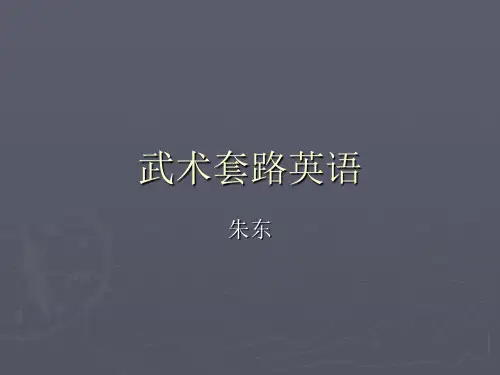
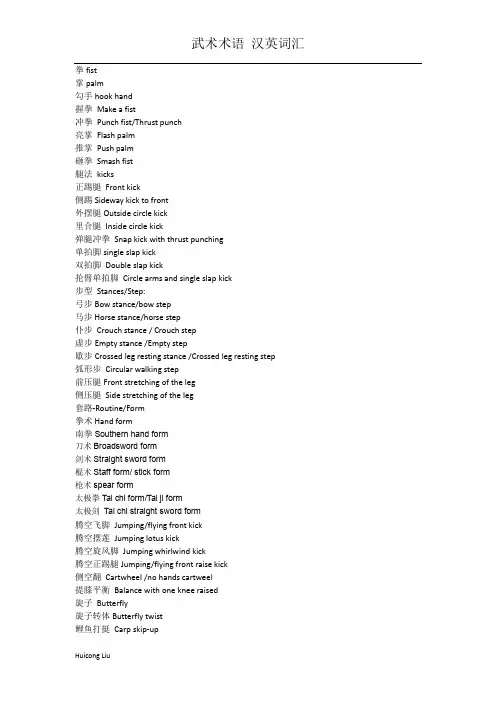
拳fist掌palm勾手hook hand握拳Make a fist冲拳Punch fist/Thrust punch亮掌Flash palm推掌Push palm砸拳Smash fist腿法kicks正踢腿Front kick侧踢Sideway kick to front外摆腿Outside circle kick里合腿Inside circle kick弹腿冲拳Snap kick with thrust punching单拍脚single slap kick双拍脚Double slap kick抡臂单拍脚Circle arms and single slap kick步型Stances/Step:弓步Bow stance/bow step马步Horse stance/horse step仆步Crouch stance / Crouch step虚步Empty stance /Empty step歇步Crossed leg resting stance /Crossed leg resting step 弧形步Circular walking step前压腿Front stretching of the leg侧压腿Side stretching of the leg套路-Routine/Form拳术Hand form南拳Southern hand form刀术Broadsword form剑术Straight sword form棍术Staff form/ stick form枪术spear form太极拳Tai chi form/Tai ji form太极剑Tai chi straight sword form腾空飞脚Jumping/flying front kick腾空摆莲Jumping lotus kick腾空旋风脚Jumping whirlwind kick腾空正踢腿Jumping/flying front raise kick侧空翻Cartwheel /no hands cartweel提膝平衡Balance with one knee raised旋子Butterfly旋子转体Butterfly twist鲤鱼打挺Carp skip-up马步冲拳thrust punch in horse stance弓步侧冲拳Punching sideway in bow stance里合腿接弓步Inside kick into bow stance弓步劈拳Chop fist in bow stance歇步勾手亮掌Hook hand and flash palm in rest stance 扣腿平衡Balance with one leg crossed behind抡臂砸拳Circle arms into smash fist前滚翻forward roll侧摔side slam/side fall仆步抡拍Circle arms and slap floor in crouch stance/step 仆步穿掌Thread palm in crouch stance/step。
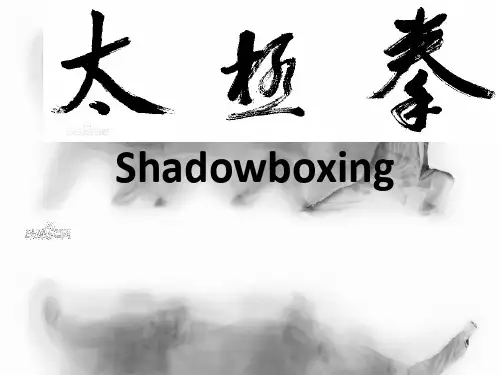
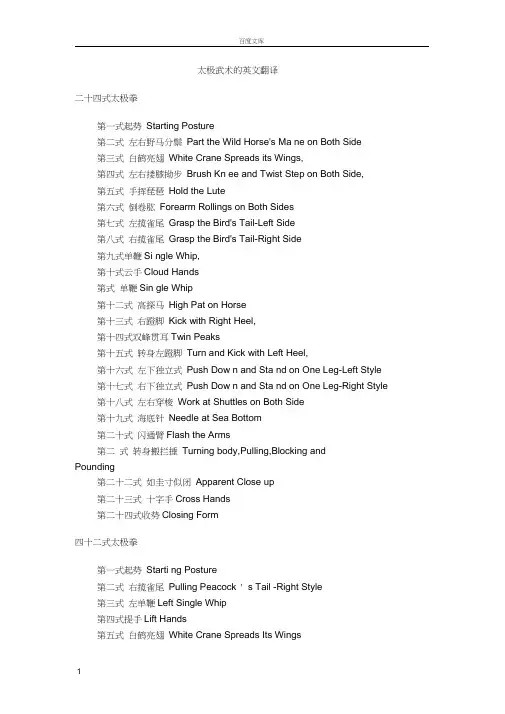
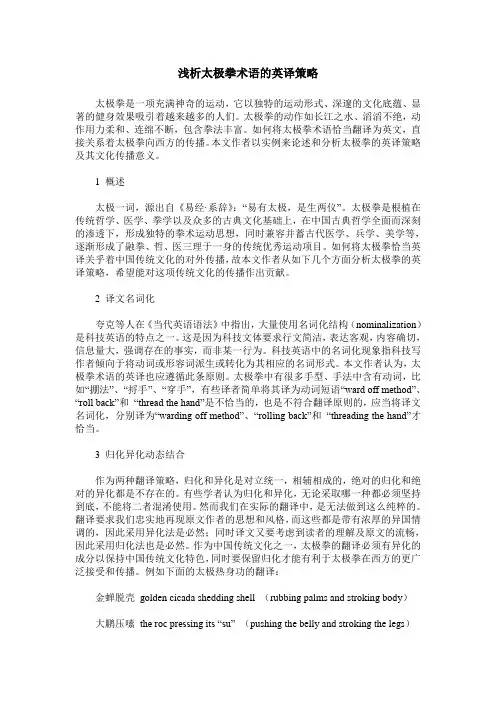
浅析太极拳术语的英译策略太极拳是一项充满神奇的运动,它以独特的运动形式、深邃的文化底蕴、显著的健身效果吸引着越来越多的人们。
太极拳的动作如长江之水、滔滔不绝,动作用力柔和、连绵不断,包含拳法丰富。
如何将太极拳术语恰当翻译为英文,直接关系着太极拳向西方的传播。
本文作者以实例来论述和分析太极拳的英译策略及其文化传播意义。
1 概述太极一词,源出自《易经·系辞》:“易有太极,是生两仪”。
太极拳是根植在传统哲学、医学、拳学以及众多的古典文化基础上,在中国古典哲学全面而深刻的渗透下,形成独特的拳术运动思想,同时兼容并蓄古代医学、兵学、美学等,逐渐形成了融拳、哲、医三理于一身的传统优秀运动项目。
如何将太极拳恰当英译关乎着中国传统文化的对外传播,故本文作者从如下几个方面分析太极拳的英译策略,希望能对这项传统文化的传播作出贡献。
2 译文名词化夸克等人在《当代英语语法》中指出,大量使用名词化结构(nominalization)是科技英语的特点之一。
这是因为科技文体要求行文简洁,表达客观,内容确切,信息量大,强调存在的事实,而非某一行为。
科技英语中的名词化现象指科技写作者倾向于将动词或形容词派生或转化为其相应的名词形式。
本文作者认为,太极拳术语的英译也应遵循此条原则。
太极拳中有很多手型、手法中含有动词,比如“掤法”、“捋手”、“穿手”,有些译者简单将其译为动词短语“ward off method”、“roll back”和“thread the hand”是不恰当的,也是不符合翻译原则的,应当将译文名词化,分别译为“warding off method”、“rolling back”和“threading the hand”才恰当。
3 归化异化动态结合作为两种翻译策略,归化和异化是对立统一,相辅相成的,绝对的归化和绝对的异化都是不存在的。
有些学者认为归化和异化,无论采取哪一种都必须坚持到底,不能将二者混淆使用。
二十四式太极拳TaijiisoneoftheChineseTraditionalmartial['mɑ:ʃəl]arts.Longlongago,itwasdesignedasauniqueandprofoundself-defensetec hnique.AsanancientKongfu,Taijiincludesquan,sword,broadsword,spear,p ush-hand,etcetera.EspeciallPpush-handiswellknownforitstactic['tækti k]a ndtechnique,thepowerfulandaggressiveopponent[ə'pəunənt]beingdefeatedbPasmallcleverattackoranabrupteGplosive[ik'spləusiv]power.AsatPpicalartfulChineseKongfu,handpushhasbeenhighlPpop ularwiththesmallandweakpeople.太极拳是中国传统武术之一,是很久以前作为一种独特而高深的自卫方法诞生的。
作为一种古老的功夫,太极包括拳、剑、刀、枪、推手等。
尤其是推手,素以技巧闻名,强大有力的对手被小而巧妙的攻击或突然的爆发力所击败。
作为典型的技巧类的中国功夫,推手备受弱小者的青睐.Concentratingoncorrectpostureandbreathingcontrol,TaiChi'smovem entsarefluid['flu(:)id],gracefulandwellbalanced,promotingthecompleteha rmonPofbodPandmind.TaiChiprovidesthementalrelaG ation[,ri:læk'seiʃən]andphPsicalfitnesssoessentialinourmodernstress-filledlives.太极动作流畅、优雅、协调,它要求精力集中在正确的姿势和呼吸上,从而全面促进身心平衡。
太极拳的英文介绍字号:大中小 Taijiquan is one of the Traditional martial arts. Initially, it functioned as a unique and profound self-defense technique. As an ancient Kongfu, T aiji includes quan, sword, broadsword, spear, push-hand, etc. Especially the push-hand is well known for its tactic and technique, the powerful and aggressive opponent being defeated by a *** all clever attack or an abrupt explosive power. As an typical artful Kongfu, hand push has been highly popular with the *** all and weak people.With the cold-weapon-age fading out, the health-care function of Taiji is increasingly gaining the importance, instead of its former role. According to the scientific research, it can improve our immune system, central nervous system, and strengthen the fitness. Because Taijiquan is a practice with a perfect bination of physical movement, deep breath and meditation. Through long years practice, many chronic diseases can be effectively cured or relieved such as neurasthenia, insomnia, neurosis, high blood pressure, stomach and intestines disease, kidney disease, arthritics, diabetes, hypochondria and even the obesity etc. So it clearly illustrates the value of Taijiquan in therapy and disease prevention.No matter you are young or aged, male or female, no matter strong or weak, slim or plump, you all can choose Taijiquan as your ideal physical exercise. When practicing it quietly and slowly, you can sense the existing of air and fully enjoy the aerobic bath, meanwhile you can also feel all the movements like the rhythmically uninterrupted waves. Taiji--- the world of Yin and Yang, the world of the nature and relaxation, will bee your a whole-new life style in the new millennium.------谨以此文献给热爱中华武术的老外们。
二十四式太极拳Twenty Four Taijiquan中文英文中文发音(Chinese Pronunciation)第一式起势Commencing form , Qishi第二式左右野马分鬃Part the Wild Horse's Mane on Both Side Zuoyouyemafenzong第三式白鹤亮翅White Crane Spreads its Wings Baiheliangchi第四式左右搂膝拗步Brush Knee and Twist Step on Both Side Zuoyoulouqiaobu第五式手挥琵琶Play Pipa Shouhuipipa第六式倒卷肱Repulse Monkey Daojuanhong第七式左揽雀尾Grasp the Bird's Tail Zuolanquewei第八式右揽雀尾Grasp the Bird's Tail Youlanquewei第九式单鞭Single Whip Danbian第十式云手Wave Hands Like Clouds Yunshou第十一式单鞭Single Whip Danbian第十二式高探马High Pat on Horse Gaotanma第十三式右蹬脚Kick with Right Heel Youdengjiao第十四式双峰贯耳Strike Opponent's Ears with Both Fists Shuanfengguaner第十五式转身左蹬脚Turn and Kick with Left Heel Zhuanshenzuodengjiao第十六式左下独立式Snake Creeps Down Zuoxiadulishi第十七式右下独立式Snake Creeps Down Youxiadulishi第十八式左右穿梭Jade Lady Weaves Shuttles Zuoyouchuansuo第十九式海底针Needle at Sea Bottom Haidizhen第二十式闪通臂Flash the Arm Shantongbi第二十一式转身搬拦捶Turn, Deflect Downward, Parry and Punch Zhuanshenbanlanchui第二十二式如封似闭Appar0ent Close up Rufengsibi第二十三式十字手Cross Hands Shizishou第二十四式收势Closing Form Shoushi。
Taijiquan is one of the Chinese Traditional martial arts. Initially, it functioned as a unique and profound self-defense technique. As an ancient Kongfu, Taiji includes quan, sword, broadsword, spear, push-hand, etc. Especially the push-hand is well known for its tactic and technique, the powerful and aggressive opponent being defeated by a small clever attack or an abrupt explosive power. As an typical artful Chinese Kongfu, hand push has been highly popular with the small and weak people.With the cold-weapon-age fading out, the health-care function of Taiji is increasingly gaining the importance, instead of its former role. According to the scientific research, it can improve our immune system, central nervous system, and strengthen the fitness. Because Taijiquan is a practice with a perfect combination of physical movement, deep breath and meditation. Through long years practice, many chronic diseases can be effectively cured or relieved such as neurasthenia, insomnia, neurosis, high blood pressure, stomach and intestines disease, kidney disease, arthritics, diabetes, hypochondria and even the obesity etc. So it clearly illustrates the value of Taijiquan in therapy and disease prevention.No matter you are young or aged, male or female, no matter strong or weak, slim or plump, you all can choose Taijiquan as your ideal physical exercise. When practicing it quietly and slowly, you can sense the existing of air and fully enjoy the aerobic bath, meanwhile you can also feel all the movements like the rhythmically uninterrupted waves. Taiji--- the world of Yinand Yang, the world of the nature and relaxation, will become your a whole-new life style in the new millennium.Tai Chi is an ancient Chinese internal martial art system, which combines profound principles, theories and martial art techniques. The slow, soft and continuously flowing movements appear mysterious on the surface. However, it is the cultivation of one's internal energy, mind and the physical body that make it so unique and challenging. To generate relaxation, Tai Chi practice requires a deep level of concentration and a focused mind, thus allowing the mind to lead and guide the body's energy.Tai Chi is not only a martial art, but has also been widely acknowledged as being an effective health exercise. Whether Tai Chi is practiced for health, as athletic sport or martial art it takes time, patience and qualitative practice to develop Tai Chi's internal properties. To achieve a high standard in Tai Chi training is a highly complex process.。
太极英文单词单词:Taiji1. 定义与释义1.1词性:名词1.2释义:太极,是一种中国传统的武术和哲学概念,强调阴阳平衡、动静结合等原理。
1.3英文解释:Taiji is a traditional Chinese martial art and philosophical concept, emphasizing the balance of yin and yang, thebination of movement and stillness, etc.1.4相关词汇:Taijiquan(太极拳,派生词)---2. 起源与背景2.1词源:“太极”源于中国古代哲学思想,最早可追溯到《易经》。
在中国传统文化中,太极是宇宙万物的本原,包含阴阳两种对立统一的力量。
2.2趣闻:传说张三丰是太极拳的创始人。
他在武当山修道时,观察蛇雀相斗等自然现象,从而悟出太极拳法。
---3. 常用搭配与短语3.1短语:(1)Taiji philosophy:太极哲学例句:Taiji philosophy has a profound influence on Chinese people's way of thinking.翻译:太极哲学对中国人的思维方式有着深远的影响。
(2)practice Taiji:练习太极例句:Many old people like to practice Taiji in the park in the morning.翻译:很多老人喜欢早晨在公园练习太极。
---4. 实用片段(1)“Look at those people over there. They are doing Taiji so gracefully.” “Yes, Taiji can no t only keep people fit but also cultivate their minds.”翻译:“看那边那些人,他们打太极打得真优雅。
太极武术的英文翻译二十四式太极拳第一式起势Starting Posture第二式左右野马分鬃Part the Wild Horse's Ma ne on Both Side第三式白鹤亮翅White Crane Spreads its Wings,第四式左右搂膝拗步Brush Kn ee and Twist Step on Both Side,第五式手挥琵琶Hold the Lute第六式倒卷肱Forearm Rollings on Both Sides第七式左揽雀尾Grasp the Bird's Tail-Left Side第八式右揽雀尾Grasp the Bird's Tail-Right Side第九式单鞭Si ngle Whip,第十式云手Cloud Hands第式单鞭Sin gle Whip第十二式高探马High Pat on Horse第十三式右蹬脚Kick with Right Heel,第十四式双峰贯耳Twin Peaks第十五式转身左蹬脚Turn and Kick with Left Heel,第十六式左下独立式Push Dow n and Sta nd on One Leg-Left Style 第十七式右下独立式Push Dow n and Sta nd on One Leg-Right Style 第十八式左右穿梭Work at Shuttles on Both Side第十九式海底针Needle at Sea Bottom第二十式闪通臂Flash the Arms第二式转身搬拦捶Turning body,Pulling,Blocking andPounding第二十二式如圭寸似闭Apparent Close up第二十三式十字手Cross Hands第二十四式收势Closing Form四十二式太极拳第一式起势Starti ng Posture第二式右揽雀尾Pulling Peacock ' s Tail -Right Style第三式左单鞭Left Single Whip第四式提手Lift Hands第五式白鹤亮翅White Crane Spreads Its Wings第六式搂膝拗步Brush Knees and Twist Steps on Both Sides 第七式撇身捶Dodge Body and Throw Fist第八式捋挤势Deflect and Squeeze 第九式 进步搬拦捶 Adva nee to Pull. Block and Pou nd 第十式如封似闭 开合手 右单鞭 肘底捶 第 第十二式 第十三式 第十四式 第十五式 第十六式 第十七式 第十八式 第十九式 第 第 第二十二式 第二十三式 第二十四式 第二十五式 第二十六式 第二十七式 第二十八式 第二十九式 第三 第三 转身推掌 玉女穿梭 右左蹬脚 掩手肱捶 野马分鬃 Appare nt Close-up Open and Close Hands Right Si ngle Whip Punch un der Elbow Tur n Body and Push Palm Work at Shuttles on Both Sides Heel Kicks on Both Sides Hide Hands and Strike Fist Wild Horses Parti ng its Ma nes on Both Sides 云手 Cloud Hands 独立打虎 Beat Tiger on Single Leg 右分脚 Toes Kick-Right 双峰贯耳双峰贯耳Twin Peaks 左分脚 Toes Kick-Left 转身拍脚 Turn Body and Slap Foot 进步栽捶进步栽捶 Advanee and Punch Down 斜飞势 Flying Obliquely 单鞭下势 Single Whip and Push Down 金鸡独立 Golden Rooster Stands on One Leg 退步穿掌退步穿掌 Step Back and Pierce Palm 卜式 虚步压掌 Press Palm in Empty Stanee 独立上托 Stand on One Leg and Raise Palm 马步靠 转身大捋 歇步擒打 第三十二式 第三十三式 第三十四式 Stricke 第三十五式 第三十六式 第三十七式 第三十八式 第三十九式 Push Forearm with Horse-Ridi ng Step Turn Body and Deflect Cross Legged Sitti ng Stance andLock 穿掌下势 上步七星 退步跨虎 转身摆莲 弯弓射虎 Pierce Palm and Push Dow n Step Forward with Seve n Stars Back Step to Mount Tiger Turn Body for Lotus Kick Draw Bow to Shoot Tiger -left第四十式左拦雀尾 Pulling Peacock ' s Tail 第四式 十字手Cross Hands 第四十二式收势Closing Form 三十二式太极剑第一式第二式并步点剑独立反刺第三式仆步横扫第四式向右平带第五式向左平带第八式独立抡劈第七式退步回抽第八式独立上刺第九式虚步下截第十式左弓步刺式第第十二式第十三式第十四式第十五式第十六式第十七式第十八式第十九式第第转身斜带缩身斜带提膝捧剑跳步平刺左虚步撩右弓步撩转身回抽并步平刺左弓步拦右弓步拦第二十二式第二十三式第二十四式第二十五式第二十六式第二十七式第二十八式第二十九式第三第三左弓步拦进步反刺反身回劈虚步点剑独立平托弓步挂劈虚步抡劈撤步反击进步平刺Sta nd with Feet Together and Point Sword Stand on One Leg and Back Thrust Sword CrouchStance and Sweep Sword Withdraw SwordRightward Withdraw Sword LeftwardStand on One Leg and Parry with Sword StepBackward and Draw Sword Back Sta nd on OneLeg and Pierce Sword Empty Stance to In terrupt with Sword Left Bow Stance and Thrust Sword Turn to Withdraw Sword Obliquely Bend Bodyto Withdraw Sword Obliquely Lift Knee andHold Sword in Both Hanks Jump Step andThrust SwordLeft Empty Stance and Cut upward SwordRight Bow Sta nee and Cut upward SwordTurn to Draw Sword BackSta nd with Feet Together and Thrust SwordLeft Bow Sta nee and Parry SwordRight Bow Stance and Parry SwordLeft Bow sta nee and Parry Sword Adva neeto Back Thrust Sword Turn Back to HackSword Backward Empty Stance and PointSword Sta nd on One Leg and Hold SwordBow Stance and Parry and Hack with SwordEmpty Stance and Parry with SwordWithdraw Step to Beat BackAdva nee to Thrust Sword卜式丁步回抽T-step and Draw Sword Back1^一式旋转平抹Rotate to Slice Horiz on tally with Sword 第三十二式弓步直朿U Bow Stanee and ThrustSword四十二式太极剑第一式第二式第三式第四式起势Start ing Posture并步点剑Stand with Feet Together and Point Sword 弓步斜削Bow Stanee and Cut Obliquely提膝劈剑Lift Knee and Chop SwordLeft Bow Sta nee and Parry Sword Left Empty Stance and Cut Upward with Sword Right Bow Stance and Cut Upward with Sword Lift Knee and Hold Sword in Both HanksHeel Kick and Thrust SwordJump Step and Thrust Sword转身下朿U Turn Body and Thrust Down 弓步平斩 Bow Stanee and Cut Horizontally 弓步崩剑 Bow Stanee and Tilt Sword 歇步压剑 Rest Stanee and Press Sword 进步绞剑 Advanee and Circle with Sword提膝上刺 Lift Knee and Thrust Sword 虚步下截 Empty Stance to Interrupt with Sword 左右平带 Withdraw Sword to Both Sides 弓步劈剑 Bow Stanee and Chop Sword 丁步托剑 T-stanee and Hold Sword Toes Kick and Point Baek Crouch Sta nee and Thrust Sword Heel Kick and Block Sword Lift Knee and Point Dow n Crouch Stance and Sweep Sword (左、右) Bow Stance and In terrupt on Both Bow Stance and Thrust Sword Wave Sword on Both SidesRight Bow Stance and Chop SwordRaise Leg Backward and Block T-step and Point Sword Horse-ridi ng Sta nee and Push Sword Sta nd on One Leg and Hold up Sword Adva nee to Parry and Point Cross Stance and Tilt Sword Bow Stance and Back Thrust Sword Turn Body and Thrust Sword Lift Knee and Sword Walk and Pierce Sword 第四十式 摆腿架剑 Wave Leg and Block Sword 第四 ^一式 弓步直刺 Bow Stanee andThrust Sword第五式左弓步拦 第六式左虚步撩 第七式右弓步撩 第八式提膝捧剑 第九式蹬脚前刺 第十式跳步平刺 第十一式 第十二式 第十三式第十四式 第十五式 第十六式 第十七式 第十八式第十九式第二十式第二^一式分脚后点 第二十二式仆步穿剑 第二十三式蹬脚架剑 第二十四式提膝点剑 第二十五式仆步横扫 第二十六式弓步下截Sides 第二十七式弓步下刺 第二十八式 右左云抹 第二十九式 右弓步劈 第三十式后举腿架剑 第三十一式 丁步点剑 第三十二式马步推剑 第三十三式独立上托 第三十四式进步挂点 第三十五式歇步崩剑 第三十六式弓步反刺 第三十七式转身下刺 第三十八式提膝提剑 第三十九式步行穿刺第四十二式收势Closing Form 第四十二式。
太极拳英文基本术语掤、捋、挤、按、採、挒、肘、靠、进、退、顾、盼、定 Peng (warding off), Lv (rolling back), Ji (pressing), An (pushing), Cai (pulling down), Lie (splitting), Zhou (elbowing), Kao (body stroke), Jin (advancing), Tui (retreating), Gu (shifting left), Pan (shifting right) and Ding (central equilibrium)不丢不顶 no releasing and resisting directly不解之谜 mystery不偏不倚 impartiality缠丝 twining沉肩坠肘 lowering the shoulders and elbows沉着 heavy and steady撑掌 unfolding palm成语之都 Hometown of Chinese Idioms抽丝 taking out the thread丹田 Dantian (pubic region)弹簧力 springy force导引术 guidance道 Tao;Dao道法自然 Taoism following the nature敌进我退,敌驻我扰,敌疲我打,敌退我追 retreating as the enemy advances, disturbing as the enemy camps, attacking as the enemy fatigues, advancing as the enemy retreats第五代传人 fifth-generation successor顶头悬 suspending the head and relaxing the neck懂劲 comprehending force动与静 motion and stillness动中寓静 stillness with motion动作 action动作/招式/招术 movement/action对立统一 the unity of opposites对立与统一 contradition and unfication;unity of the opposites 耳提面命 whispering into disciples’ ears and talking face to face发劲 discharging force法道修身 self-cultivation with Tao法道治国 state-governing by Tao反者道之动,弱者道之用 The application of Dao is using mildness rather than violence, softness rather than hardness非圆即弧 either circle or arc刚柔相济 combining hardness with softness根于脚,主宰于腰,行于手指 rooting with feet, leading with waist, and moving with fingers弓步 n.bow stance; v.lunge forward功夫 Gongfu; Kungfu;fighting art;fighting skills攻防 attack and defense; offense and defense攻防搏击 offensive and defensive fighting贯串之意 Yi of permeating国术馆 National Martial Arts Gyms含胸拔背 contracting the chest and lengthening the back合中有开 closing with opening后发制人 striking only after being struck呼、发、伸、进、起、仰、往、出、放、打、击、刚、动、实、开、升、上、左 breathing out, attacking, extending, advancing, raising, facing upward, going, sending, releasing, hitting,striking, hardness, moving, solidness, opening, lifting, ascending,turning left呼与吸 breathing out and breathing in化劲 dispersing force技击术 art of attack and defense节节贯串 joints’ coordinating借力打力 transforming the coming force to attack the opponent 劲整 integrating force经络 Jingluo (main and collateral channels)经络中通行的气 Qi (air) in Jingluo精神 mind静中寓动 motion with /in stillness卷(蓄)与放 storing and discharging开胯屈膝 separating the thighs and bending the knees开与合 opening and closing开中有合 opening with closing快与慢 rapidness and slowness老子学说 Laozi’s Doctrines砺练品格 morality training练劲 building up power练巧 mastering techniques练顺 smoothing out the frame螺旋 volution螺旋缠绕 spiral enwinding落点(劲点) attacking points (positions)门规戒条 doctrines, regulations and restrictions内不动,外不发 no internal Yi (mind), no external movements 内劲 Neijin (inner power)内劲潜换 inner power exchanging内气 Neiqi (inner air)内外皆修 internal and external cultivation内外统一 uniting mind with body偏心距 eccentric distance平和安静,谦和大度,博爱真诚,感恩包容 gentleness and peace, modesty and generosity, love and sincerity, gratitude and tolerance平心静气 calming mind气沉丹田 Qi Chen Dantian (storing qi in the pubic region)气敛 Storing Qi (spirit;air)牵一发而动全身 a slight move in one part may affect the whole situation乾坤 Qiankun (heaven and earth, the universe)强身健体 body building and physical fitness窍 aperture轻灵 agile轻与沉 lightness and heaviness全国武术锦标赛 Championship of National Martial Arts拳法 boxing method拳理 boxing theory拳式 movement拳姿 boxing posture人不犯我、我不犯人、人若犯我、我必犯人 We will not attack unless we are attacked; if we are attacked, we will certainly counterattack.柔与刚 softness and hardness儒雅端庄 refined and dignified散手 San Shou (free sparring)上下相随 the harmony between the upper and lower body舍己从人 giving up one’s own to accept the widely-accepted one 身心双修 physical and spiritual cultivation神 Shen (concentration of the mind)神聚 concentrating the attention神明 sprirtual illumination十大文化脉系 ten major regional cultures十三势 Thirteen (13) Postures收敛入骨 storing in the body疏通经络 activating channels四两拨千斤 defeating the strong with little effort松静自然 being natural, relaxed and quiet松柔缓慢 soft and slow松腰圆裆 relaxing the waist and separating the thighs宋明理学 Neo-Confucianism太极拳 Taijiquan;Tai Ji Quan;Tai Chi;Taiji boxing;Shadow boxing 太极拳圣地 Hometown of Taijiquan太极拳小架子 the small frame of Taijiquan太极图 Taiji Diagram陶冶情操 molding character套路 routine体育运动学 sports and kinematics天地与我并生,万物与我为一。
The nature lives with me in symbiosis, and everything is with me as a whole.天人合一 Tian Ren He Yi (harmony between Man and Nature )听劲 judging the opponent’s force推手 Tui Shou (pushing hands)唯物辩证 Dialectical Materialism尾闾 Wei Lv( acupoint; tailbone)未老先防 anti-aging prevention before growing old温文尔雅 gentle and elegant文化内涵 cultural connotations文静自然 quiet and natural文拳 Wenquan (Boxing of Thoughts)文武兼修 adept with pen and sword文追鸿儒,痴迷拳术 versed in polite letters and obsessed with martial arts无过不及,不偏不倚 no excess, no deficiency无为而为;无为而治 actionless governance doing nothing that goes against nature五阴并五阳 half Yin and half Yang五趾抓地 feet grasping the ground武术 martial arts; wushu物极必反 Extremes Meet吸、蓄、屈、退、落、俯、来、入、收、化、引、柔、静、虚、合、降、下、右 breathing in, storing, bending, retreating, dropping, leaning, coming, entering, holding, dispersing, guiding, softness, quietness, emptiness, closing, falling,descending, turning right先天气 Xiantianqi (congenital air)行云流水 flowing clouds and running water形神共养 cultivating both the mind and the body形神皆备 spirit and appearance likeness修身养性 self-cultivation虚领顶劲 erecting the head and relaxing the neck; erecting the head and neck naturally虚其心,实其腹 emptying one’s mind and filling one’s stomach 虚实 Xu Shi;voidness and solidness;emptiness and solidness旋踝转腿 rotating the ankles and legs旋腕转膀 rotating the wrists and shoulders旋腰转脊 rotating the waist and back穴 acupoints延年益寿 keeping longer longevity;longevity prolonging养生术 science of health preserving一静一动 stillness and motion一开一合 opening and closing一招不慎全盘皆输 one careless move loses the whole game以静制动 coping with all motions by remaining motionless以柔克刚 overcoming hardness with softness以弱胜强 conquering strength with weakness以退为进 retreating in order to advance以武载道 incorporating cultural elements into martial arts以小力胜大力 defeating the strong with little effort; conquering strength with weakness以意导动 conducting movements with Yi意 Yi (mind)阴阳 Yin and Yang; Yin-Yang;Yin/Yang阴阳互根 Yin and Yang rooting in each other阴阳相济 Yin and Yang assisting each other;Yin and Yang existing; Yin and Yang existing together阴阳学说 Yin-Yang Theory用法之意 Yi of directions用意 using Yi元气 Yuanqi (vitality)原始道家 the original Taoism原始儒家 the original Confucianism圆活饱满 softness and fullness圆与方 circle and square沾连粘随 Zhan Lian Nian Sui (touching, sticking, adhering and following)哲拳 Zhequan (Boxing of Philosophy)正气 Zhengqi (pure air)致虚极,守静笃 finding rest and peace, and feeling ease中国传统医学 TCM;traditional Chinese medicine中国佛学 Chinese Buddhism中国古典哲学 Chinese classical philosophy中气 Zhongqi (air in internal organs)中正和谐 Harmony and Perfection中正之说 Notion of Zhong and Zheng (Harmony and Perfection) 着熟 be skilled姿势 posture自强不息 endless and tireless;constantly strive to be stronger;make unceasing efforts to improve oneself。